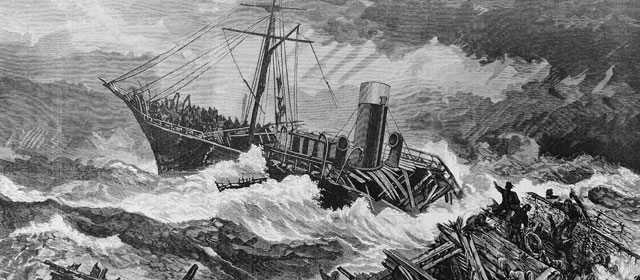He korero whakarapopoto
Māori canoes
When Māori first came to New Zealand by canoe, some of these were wrecked. One story is of the Pounamu people who came in the Tairea canoe, which was wrecked on the West Coast. They were chased by enemies, and the people turned into greenstone (pounamu) so that they could hide.
The Ārai-te-uru canoe was hit by a storm on the coast of the South Island. Tradition has it that the kūmara (sweet potatoes), gourds and eel pots it was carrying washed onto the beach and became the large round boulders at Moeraki.
Dangers
In the 1800s there were many disasters at sea and many people died. Sailing ships were wrecked because:
- Maps of the coastline were not good.
- There were few lights and lighthouses to guide ships.
- Ships were wooden and could catch fire or break up when they hit rocks.
- Some ports had sand or shingle bars and ships got stuck on them, and some ports were open to ocean storms.
- Some captains were not well trained.
Better safety
In the 1900s travelling at sea became safer. Ships were built from iron or steel. Rather than sails, they had steam engines that were powerful and helped them get out of trouble.
More lighthouses were built. Maps were drawn with more detail on them. Breakwaters were made, so harbour waters were calmer, and there were more tugs to tow ships into port.
Some famous shipwrecks
The Orpheus was the wreck with the greatest loss of life in New Zealand waters. It sank on 7 February 1863 when it struck a sandbar near Auckland. Of the 259 people on board, 189 died.
The second greatest wreck was on 29–30 April 1881 when the Tararua hit a reef at Waipapa Point, Southland. In all, 131 people died. Most were washed overboard and drowned as the rescuers could not reach them because of high seas.
On 29 October 1894 the Wairarapa was travelling in thick fog, and it slammed into cliffs on Great Barrier Island, north-east of Auckland. Many people were swept away by the sea. Of the 251 passengers and crew on the ship, 121 died.
Modern-day shipwrecks
On 10 April 1968 a cyclone met a southerly front, and this produced very strong winds. The Christchurch–Wellington ferry Wahine was hit by this storm and struck Barrett Reef near Wellington Harbour. A propeller was knocked off and one engine stopped working. The ship leaned to one side, so only half of the lifeboats could be launched. Many of the life rafts flipped over in the wild seas. Of the 734 people on the ship, 51 died.
The Greenpeace ship Rainbow Warrior was blown up and sunk in Auckland by French secret-service agents in 1985, and one person was killed. The ship was towed to Northland and re-sunk, and it is now a place for divers to explore.
The Mikhail Lermontov was a passenger cruise ship that hit rocks and sank in the Marlborough Sounds in 1986. All the passengers were saved, but one crew member drowned. The ship was left where it was and is a site for divers to visit.





